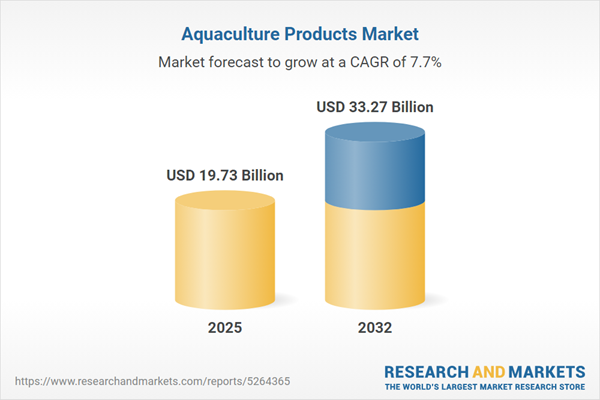Speak directly to the analyst to clarify any post sales queries you may have.
The aquaculture products market is undergoing significant evolution as industry leaders prioritize innovation, regulatory compliance, and supply chain resilience. Senior executives are actively transforming operations, implementing digital technologies, and redefining strategies to maintain growth and competitive differentiation in the sector.
Market Snapshot: Aquaculture Products Market Size and Growth
The global aquaculture products market is on a steady growth path, with revenues reaching USD 18.36 billion in 2024 and projected to rise to USD 19.73 billion by 2025, aiming for USD 33.27 billion by 2032—a compound annual growth rate (CAGR) of 7.70%.
Market expansion is reinforced by the broad adoption of sustainability-focused practices, digital transformation across the value chain, and robust approaches to supply chain management. Senior decision-makers leverage innovation and compliance-focused investments to enhance operational efficiency, align with dynamic regulations, and deliver consistent value across global and regional operations.Aquaculture Products Market: Scope & Segmentation
- Product Types: This segment encompasses chemicals, additives, and fertilizers that support animal health and overall biosecurity, as well as advanced molecular feed solutions and smart water management systems aimed at boosting productivity and minimizing risks.
- Species: Organizations address diverse needs across shrimp, crab, tilapia, salmon, oysters, mussels, and seaweed, aligning product portfolios with changing demand patterns in both established and emerging markets.
- Culture Systems: Includes cage culture, pond operations, recirculation systems, and flow-through techniques, each supporting different scalability, flexibility, and regulatory requirements in production.
- Farming Environments: Companies utilize brackish, freshwater, and marine systems to ensure ecological balance and reinforce sustainable supply chains across varied geographic settings.
- End Users: The market serves commercial-scale operators, ornamental fish businesses, and research-based entities, demonstrating the importance of tailored technology and specialization opportunities.
- Distribution Channels: Covers direct sales, distributor frameworks, wholesale supply, and digital procurement avenues, enabling quick response and efficient inventory management for varied buyer profiles.
- Regional Coverage: The Americas, Europe, Middle East & Africa, and Asia-Pacific are pivotal regions, with the United States representing a primary market. China, India, Germany, Saudi Arabia, and Australia are recognized for driving sector competitiveness, expansion, and investment.
- Leading Companies: Key players include KAPP ehf, Marel, Aanderaa by Xylem, Adisseo, BAADER, Innovasea, and Pentair Aquatic Eco-Systems. These organizations are adapting their portfolios to address both regulatory changes and evolving industry demands.
Aquaculture Products Market: Key Takeaways for Decision-Makers
- The integration of artificial intelligence and advanced analytics is enhancing feed strategies and real-time site monitoring, leading to improved decision quality and smarter resource use.
- Investing in modern containment and recirculation technology advances environmental compliance and helps meet evolving reporting and sustainability expectations from both customers and regulators.
- Diversifying supplier and partnership networks is a vital approach to reducing vulnerability and managing operational costs in a dynamic global supply environment.
- Broadening offerings to include both mainstream and alternative species, as well as evolving cultivation techniques, allows producers to respond efficiently to shifting consumer preferences and reduce exposure to market uncertainties.
- The adoption of digital traceability and certification systems is increasing transparency and accelerating technology adoption, helping organizations meet strict regulatory and stakeholder mandates.
Tariff Impact: Navigating Trade Changes
Recent variability in U.S. tariffs is contributing to increased procurement and price instability within the aquaculture products market. Strategic leaders are responding by diversifying sourcing strategies and embedding risk management protocols, which help protect business continuity and reduce the impact of unpredictable trade conditions.
Methodology & Data Sources
This report draws on in-depth executive and regulatory interviews and is enhanced by rigorous analysis of market data and academic resources. Data triangulation methods support the precision and reliability of all findings and recommendations provided.
Why This Aquaculture Products Market Report Matters
- Offers a strategic blueprint enabling executives to align with shifting regulatory frameworks and capitalize on digital advancements across all aspects of the aquaculture products market.
- Supports comparative benchmarking, allowing organizations to anticipate market shifts, manage change smoothly, and drive ongoing operational improvements.
- Presents actionable insights on core market segments, providing guidance for procurement decisions, innovation efforts, and identification of new regional and sectoral growth opportunities.
Conclusion
This report equips senior decision-makers with practical insights needed to steer organizational transformation, manage risks, and support sustainable practices within the aquaculture value chain.
Additional Product Information:
- Purchase of this report includes 1 year online access with quarterly updates.
- This report can be updated on request. Please contact our Customer Experience team using the Ask a Question widget on our website.
Table of Contents
3. Executive Summary
4. Market Overview
7. Cumulative Impact of Artificial Intelligence 2025
Companies Mentioned
The companies profiled in this Aquaculture Products market report include:- KAPP ehf
- Marel
- Aanderaa by Xylem, Inc.
- Adisseo
- AGK Kronawitter GmbH
- Applied UV
- Aqua Logic
- Aquaculture Equipment Ltd
- Aquarius Systems
- Aquatic Equipment and Design, Inc.
- BAADER
- FEEDING SYSTEMS, S.L
- Foshan Miaofei Aquarium Equipment
- Guangzhou Zhonghang Environmental Tech
- Innovasea
- Jiangsu G & G Netting
- LINN Gerätebau GmbH
- Norfab Equipment Ltd
- Pentair Aquatic Eco‑Systems
- Qingdao Haosail Machinery Co., Ltd
- Shenyang Aerti Tech Co., Ltd.
- Sino‑Aqua Corporation
- Tele Net
- Weda AB
- Zhongshan Ewater Aquaculture Equipment
Table Information
| Report Attribute | Details |
|---|---|
| No. of Pages | 189 |
| Published | October 2025 |
| Forecast Period | 2025 - 2032 |
| Estimated Market Value ( USD | $ 19.73 Billion |
| Forecasted Market Value ( USD | $ 33.27 Billion |
| Compound Annual Growth Rate | 7.7% |
| Regions Covered | Global |
| No. of Companies Mentioned | 26 |









